Gamification Statistics And Trends
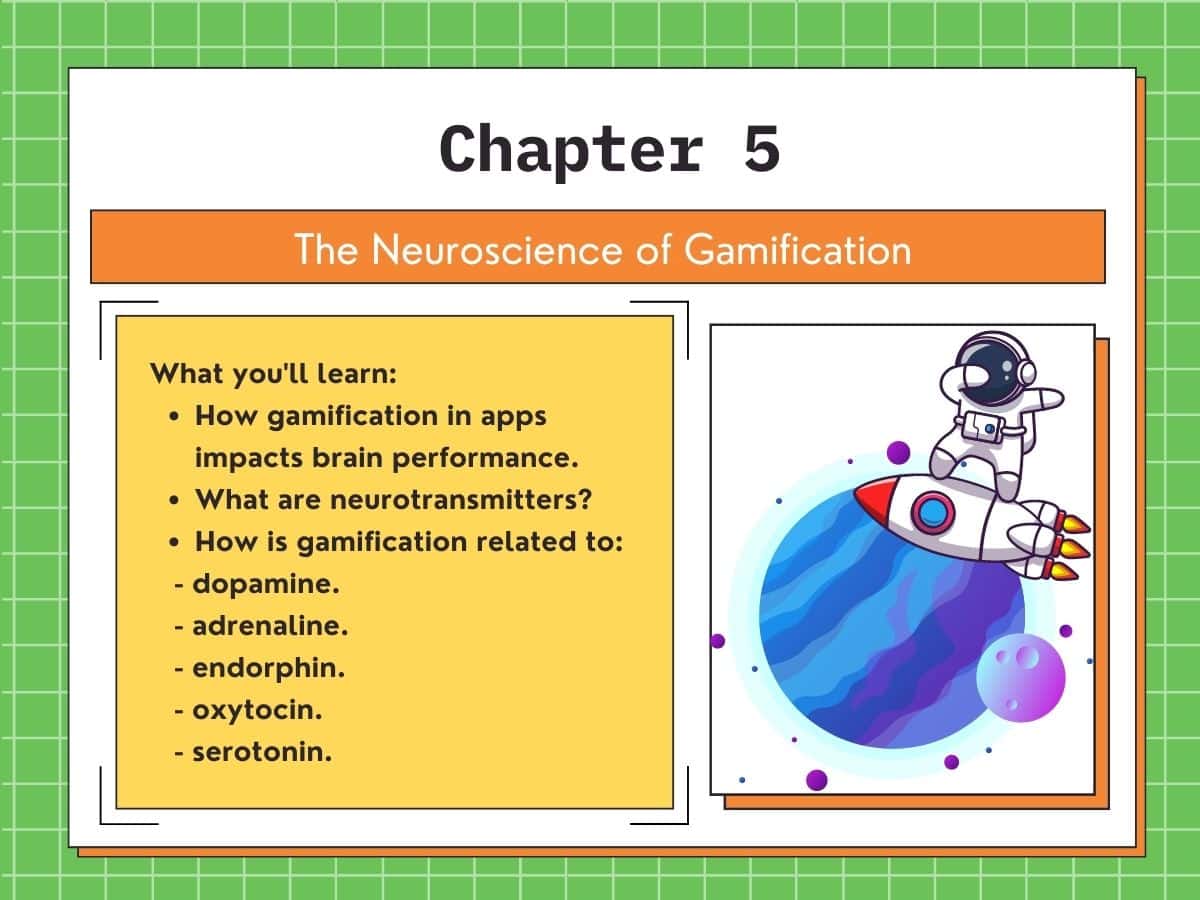
In this chapter, we’ll explore the development of gamification through the latest statistics. The data we’ll share reveals the present gamification landscape and hints at the upcoming trends. How will these new developments transform the business scene? Most importantly, how can you use them to create more effective and engaging gamified initiatives?
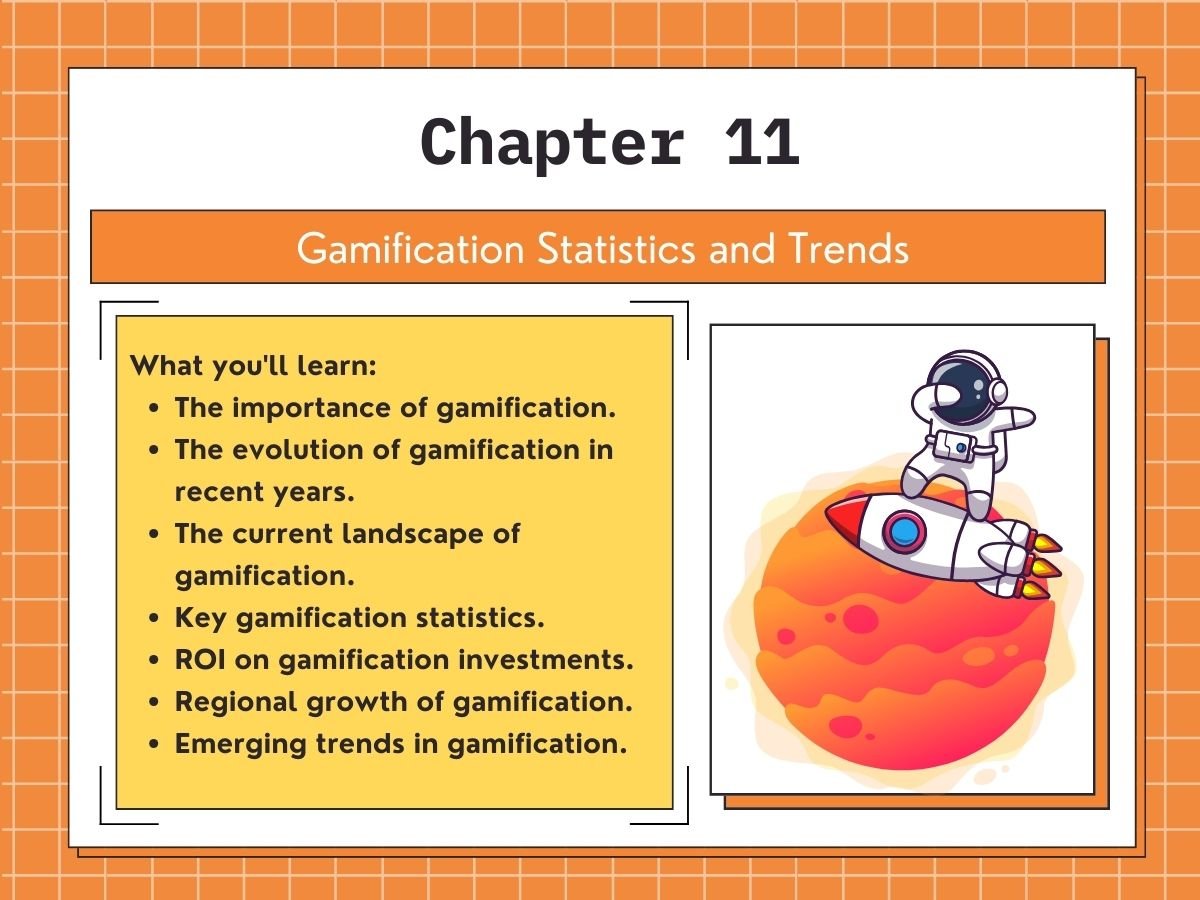
Chapters
You are in Chapter 7 of the Beginner’s Gamification Guide.
Most of us typically view the corporate sectors as dull and routinary. Fortunately, it is experiencing a significant transformation. Gamification, which started as an intriguing idea, has become essential for boosting customer and employee engagement and motivation.
This approach isn’t just making marketing campaigns more engaging and transforming how we learn in educational environments. Most importantly, it changes how we interact with different products in the market. By incorporating elements of gameplay, we’re seeing actual results and enjoyment.
So, how effective is gamification? That’s our focus for this chapter. Let’s dive into the latest statistics and insights on gamification to prepare you with key knowledge as we move into 2024.
Gamification has evolved into a refined method for boosting user engagement and business development. Its growth demonstrates that businesses understand its powerful impact on user behaviour and achieving company objectives. Let’s take a walk and trace how gamification has grown in complexity and effectiveness over the years.

From points to experiences
Back then, gamification was primarily associated with basic game elements like points, badges, and leaderboards (PBL). The focus was on creating competitive environments through these simple mechanics.
However, as businesses and designers delved deeper, it became apparent that gamification had the potential to offer much more. The narrative shifted towards creating holistic and meaningful experiences seamlessly integrating with the user’s journey. Now, it’s about fostering intrinsic motivation and creating value-driven engagement rather than extrinsic rewards.
Technology as a catalyst
The technologies that emerged recently significantly played a part in the evolution of gamification. Advances in artificial intelligence (AI), machine learning, and data analytics have led to more personalised and complex gamified experiences. Thanks to them, organisations have gained deeper insights into user behaviour and preferences.
Augmented reality (AR) and virtual reality (VR) also expand the horizons for gamified experiences. These two technologies are merging the virtual and real worlds into immersive interactions.
Expansions in different sectors
Gamification has broken the confines of its initial applications. Today, it has spread across various sectors, including education, healthcare, corporate training, fitness, and social causes, to name a few.
Platforms like Duolingo have successfully gamified language learning, which makes the entire experience fun and effective. Similarly, the fitness sector has seen a surge in gamified apps, making working out more engaging and rewarding.
Gamification for social good
The real-world impact of gamification is expansive. Gamification today isn’t just about online interactions but driving positive behaviour changes toward users and customers. Moreover, you can use it to improve skill acquisition and foster community engagement.
Gamification is increasingly recognised as a means for driving social change, with numerous organisations leveraging it to support their missions.
Move towards ethical gamification
As gamification becomes more popular, the focus on using it ethically is growing. There’s a stronger push to ensure that it benefits users without causing addiction or harm. This responsible approach to gamification reflects a deeper, more mature grasp of its possibilities.
The promising future of gamification
Gamification’s future looks bright. Advances in technology, insights into user psychology, and dedication to ethics are poised to define its next chapter. These elements are set to make gamification a key component of user experiences in multiple sectors and industries.
The gamification landscape is rapidly evolving, marked by substantial growth and widespread adoption across different sectors. Gamification has emerged as a significant force in the market. This is evident in its increasing value and seamless integration into various industries.
Global Adoption and Market Value
The broader acceptance and integration of gamification across different sectors have resulted in the growth of the global gamification market. The data below indicates the trend of increasing market value and broader adoption.
Market Growth Over the Years
The gamification market has seen substantial growth over a short period. The gamification market back in 2020 stood at around $9.1 billion. But by 2025, experts expect it to climb to a whopping $30.7 billion, reflecting a 27.4% CAGR.
To put things into perspective, the gamification market size 2022 was $14.87 billion. But after a year, it increased to $18.64 billion. Predictions even suggest that the market will reach $46.44 billion by 2027.
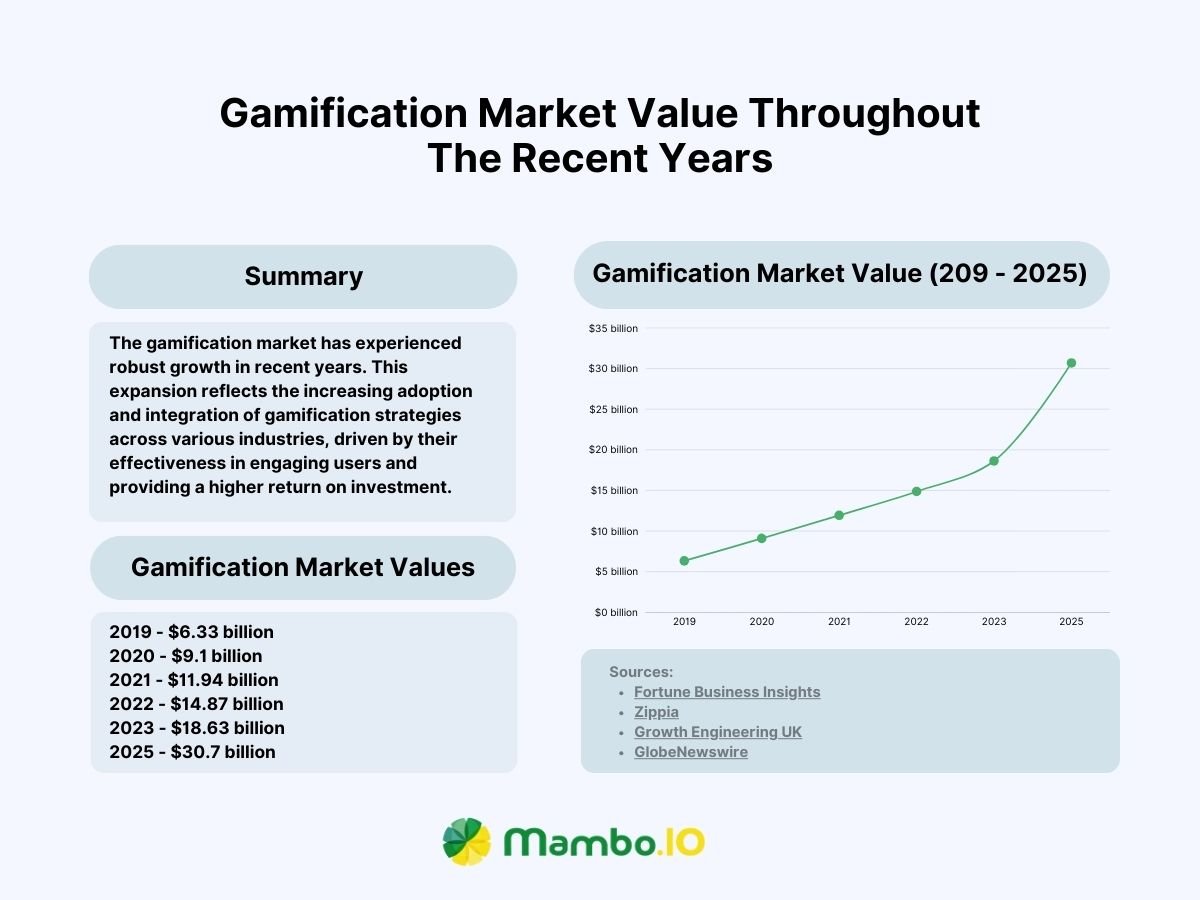
Factors driving growth
The upward trend in the gamification market size results from various factors. For starters, recognising gamification’s potential to improve metrics such as engagement and performance has fueled its adoption across different sectors. Technological advancements have also made it easier and more cost-effective for businesses to integrate gamification strategies.
Industries most influenced by gamification
The rise in the market value of gamification is partly due to its adoption across critical industries. For example, the education sector is rapidly adopting gamification. By 2025, the market is anticipated to hit $27.5 billion, climbing at a yearly rate of 14%.
Furthermore, the growth is being propelled by sectors like marketing, healthcare, and employee training. All sectors mentioned have a combined market value of over $18 billion in 2023.
- The fact that 70% of industry leaders use gamification shows it’s not just for games anymore. They’re using it to get more engagement and reach their business goals. This adoption rate clearly recognises its benefits – namely, driving motivation and engagement and fulfilling specific business objectives.
Gamification’s reach extends across various sectors, with mobile technologies taking a front seat. Developers are designing gamified mobile apps to tap into the extensive smartphone user market. Moreover, AI is propelling gamification forward, offering tailored and adaptive experiences that make every user interaction distinct and captivating.
Furthermore, gamification’s influence has transcended entertainment, now playing a significant role in education, healthcare, and corporate training. Integrating the Internet of Things (IoT) with gamification is also a significant development. It adds interactivity to experiences by blending physical activities with digital rewards and tracking. This combination helps to boost user involvement in tasks and learning activities.
Increase in engagement and productivity due to gamification

Aside from being merely engaging, gamification is also a significant driver of productivity.
Research indicates that 90% of employees report increased productivity when game-like elements are integrated into their tasks. This proves that gamification provides tangible and measurable results more than just feelings of being productive.
Here’s another example: in the U.S., 61% of employees undergoing gamified training find the process fun and interactive and more effective. The benefits of gamification extend to employee well-being, with an 89% surge in employee happiness reported. This increase in morale can lead to a 50% rise in organisational productivity for companies that adopt gamification.
Financially, the numbers are just as compelling, with companies employing gamification strategies being seven times more profitable. Furthermore, gamified learning engages about 30% more employees than traditional methods. Gamification has proven to be an essential factor in cultivating a productive and engaged workforce.
- Incorporating gamification proves highly beneficial for many companies. On average, those who apply gamified strategies experience nearly a 50% increase in productivity.
- Moreover, these companies often report sevenfold profitability margins compared to businesses without gamification. These statistics highlight the significant, real-world advantages of gamification in business processes.
Employee engagement, satisfaction, and retention
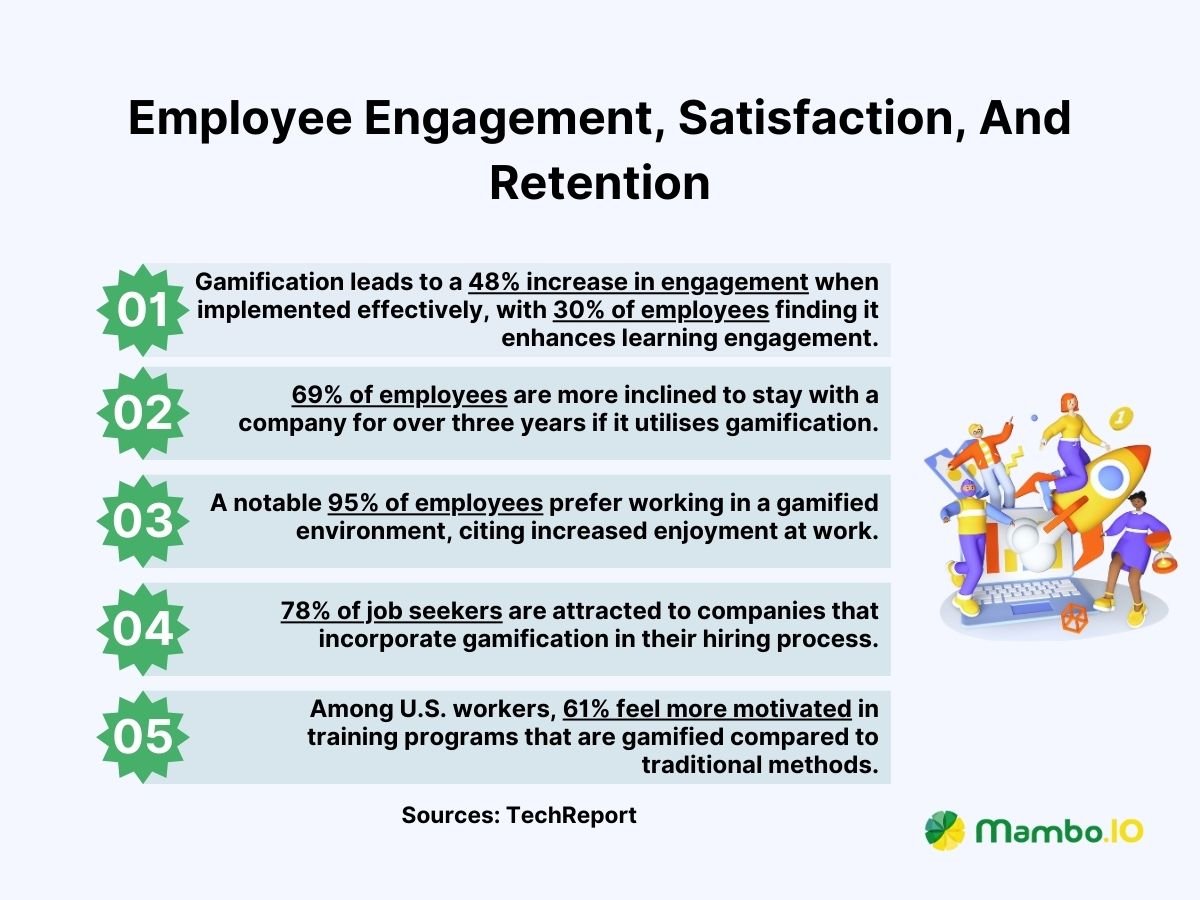
Gamification markedly boosts employee engagement, showing a 48% increase when implemented correctly. Additionally, 30% of employees find that gamification makes learning more engaging.
It’s also a powerful tool for employee retention. 69% of employees are likelier to stay with a company that has used gamification for over three years.
Additionally, an impressive 95% prefer to work for companies that implement these strategies. A staggering 95% of employees favour a gamified work environment because it makes work more enjoyable.
This approach also influences recruitment, as 78% of job seekers are drawn to companies that use gamification in their hiring process. Regarding training, 61% of U.S. workers undergoing gamified programs feel more motivated than with conventional approaches.
Maximising productivity and profitability
An impressive 90% of employees report that gamification has boosted their productivity. This fact aligns with a notable 48% rise in engagement when workplaces integrate gamified techniques. The impact on profits is equally significant; companies that employ gamification outpace their competitors by a factor of seven. And unsurprisingly, this advantage isn’t just internal – it also enhances customer interactions.
Boosting customer engagement and loyalty
Gamification in marketing can lead to a 48% surge in customer engagement, sometimes even doubling it. The interactive and fun experience organisations provide deepens customer interactions. This can result in a 30% uptick in their time on apps or websites.
Plus, companies with gamified loyalty programs report a 22% increase in customer retention. This showcases the effectiveness of rewards such as points and badges in fostering brand loyalty.
Enhancing conversion rates and sales performance
Gamification can elevate a company’s conversion rates by as much as 50%, thanks to its psychological edge. Time-sensitive challenges and unique rewards generate urgency, prompting users to act swiftly and purchase.
Additionally, sales teams can see their performance surge by up to 3.5 times with the implementation of gamified sales contests and leaderboards. These tools tap into their competitive spirit, motivating them to drive better sales results.
The lens through which we view employee engagement and training is rapidly changing. This is thanks in part to the innovative attributes of gamification.
This dynamic approach reshapes how tasks and learning are perceived in the workplace, turning the mundane into engaging. Ultimately, it fosters an environment where productivity and enjoyment go hand in hand.
Let’s go over the key gamification statistics you need to watch out for in 2024
Gamification in education
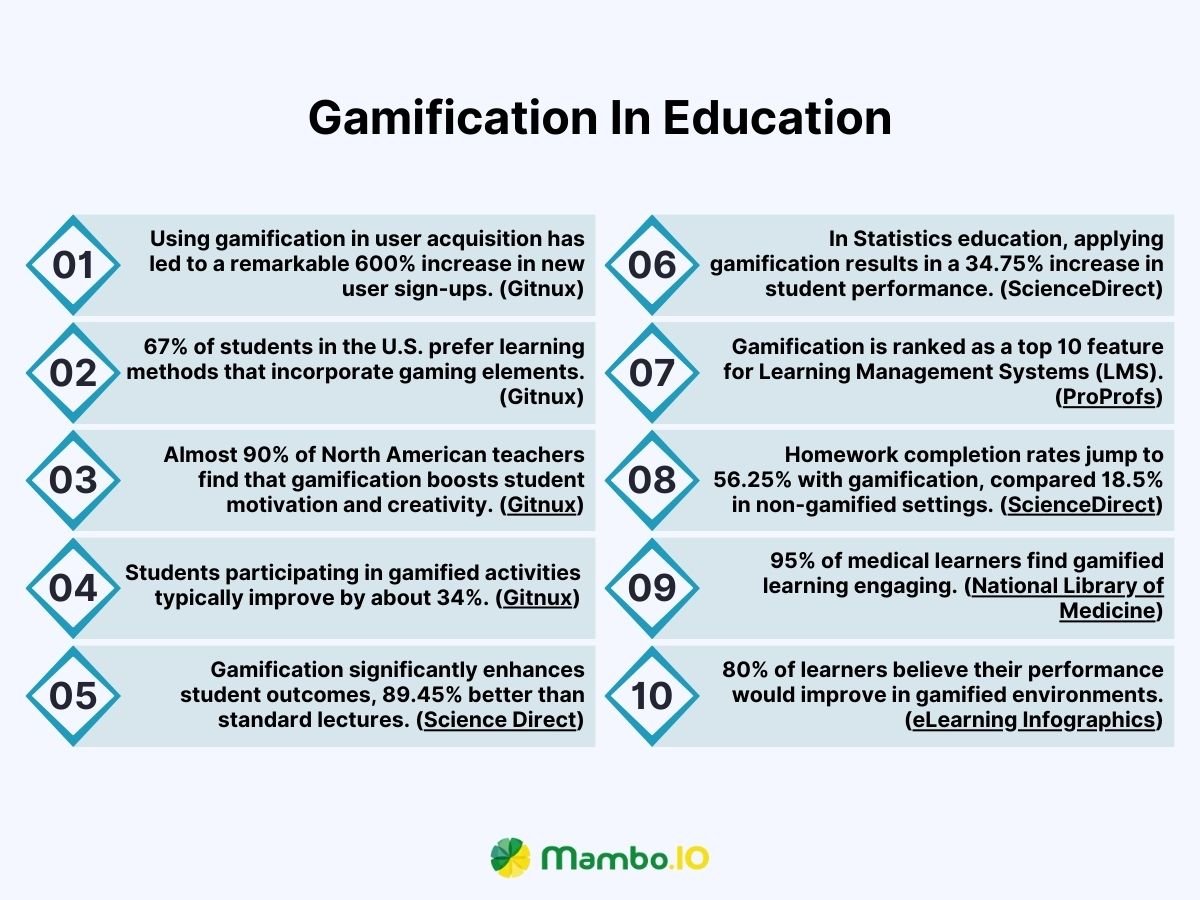
Gamification is transforming education. This strategy has shown promise in enhancing student engagement and performance by weaving game mechanics into learning. The latest numbers tell an impressive story of gamification’s effectiveness in education.
Increase in the use of gamified learning platforms
The educational landscape has seen a substantial uptick in adopting gamified learning platforms. Gamification’s role in skill enhancement is evident, as assessment scores are 14%
higher than traditional methods in gamified settings. This approach has also proven a formidable tool in user acquisition, boasting a 600% increase in new user registrations.
Student engagement and performance stats
Gamified learning is notably preferred, as statistics show that 67% of U.S. students favour educational methods that include game elements. These elements range from rewards to competition, enhancing engagement.
Game-based learning in higher education isn’t a transient trend; it’s projected to expand by 15.4% between 2019 and 2024. This growth trajectory targets a market size of $25.7 billion by 2025.
Notably, students engaged with gamified learning exhibit an average 34% improvement in test scores. Nearly 90% of instructors in North America believe that gamified learning amplifies student motivation and creativity.
Students engaging with gamified challenges see an average improvement of nearly 35%, with some experiencing boosts as high as 89.45% over conventional classroom settings. Plus, 67% of students feel that gamified courses are more engaging and motivating than regular ones.
Other education gamification statistics you need to know
- Challenge-based gamification can boost student learning outcomes significantly, with an impressive 89.45% improvement over traditional lectures. (Science Direct)
- Students show a 34.75% increase in overall performance when gamification is applied in Statistics education. (ScienceDirect)
- Learning management systems (LMS) benefit greatly from gamification, ranking it among the top 10 features. (ProProfs).
- The introduction of gamification has increased homework completion rates, soaring to 56.25% from a mere 18.5% in non-gamified environments. (ScienceDirect)
- A whopping 95% of medical learners found gamified learning engaging, with 74% favouring it over traditional lectures. (National Library of Medicine)
- A significant 80% of learners believe they would achieve more if their educational or professional settings were gamified. (eLearning Infographics)
Gamification in corporate training
Given its growing impact on the market, it’s becoming more critical for organisations to gamify their corporate training. Gamification taps into our natural tendencies towards competition and achievement, making employee learning more engaging. Let’s look at some key statistics demonstrating how effective gamification has become in boosting corporate training programs.
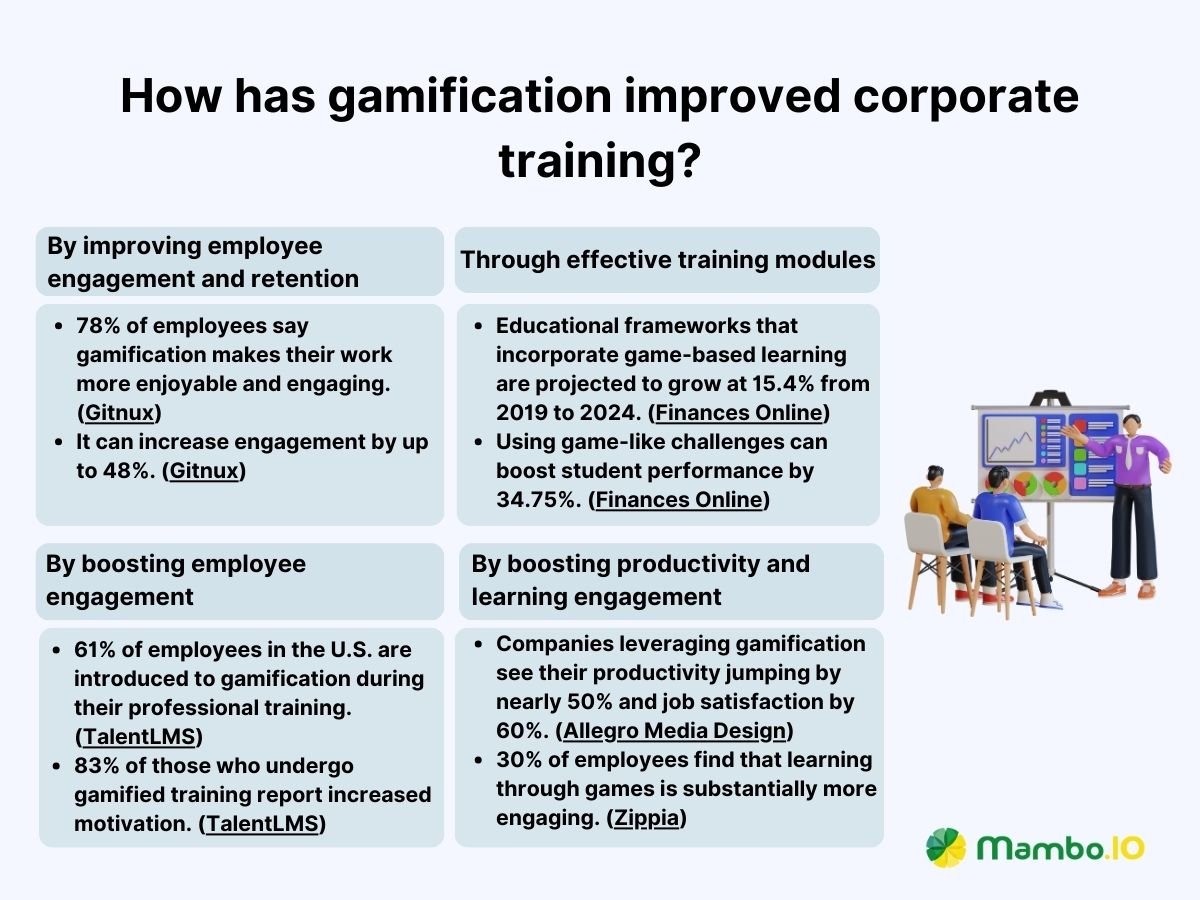
Employee engagement and retention stats
Gamification is a powerful tool for boosting employee engagement, a key element in the workforce.
An impressive 78% of employees say gamification makes their work more enjoyable and engaging. It can increase engagement by up to 48%, highlighting its significant influence on how teams function.
Beyond keeping employees engaged, gamification taps into their desire for progress and skill development. Around 30% of employees are motivated by the opportunity to tackle more challenging tasks in a gamified setting.
Effectiveness in training modules
The efficacy of gamified training modules is undeniable. Educational frameworks incorporating game-based learning are projected to grow 15.4% from 2019 to 2024.
This growth is not without merit, though. Using game-like challenges can boost student performance by 35%, clearly showing it helps students improve.
Engagement through gamification
Organisations today fully understand that ensuring employee satisfaction and retention is more important than ever. This approach has enhanced social connections, created a community feel, and increased productivity. Because of these capabilities, gamification is a trend here to stay, with over 70% of top global companies already on board.
According to TalentLMS, 61% of employees in the U.S. are introduced to gamification during their professional training. Incorporating gaming elements in training resonates positively, with 83% of those who undergo gamified training reporting increased motivation. In contrast, 61% find traditional training methods without gamified elements to be dull and boring.
Boosting retention through gamification
Gabe Zichermann, the author of “Gamification by Design”, points out that adding game elements to work-related training can boost skill retention by around 40%. This suggests that gamification is more than just a buzzword but a strategy that makes learning stick, especially for employees.
Productivity and learning engagement through gamification
Companies leveraging gamification are seeing tangible results, with productivity jumping by nearly 50% and job satisfaction by 60%. 30% of employees also find that learning through games is substantially more engaging, emphasising the value of interactive training methods.
Moreover, those implementing gamification are found to be seven times more profitable than those who don’t. This fact means that gamification isn’t a catchy trend anymore but a promising strategy with potential return on investments (ROI).
Other employee training gamification statistics you need to know
- Companies that dedicate 25% to 50% of their sales training funds to management training often exceed their target by 6%. (Level Eleven)
- Half of U.S. startups are now applying gamification strategies. (ResearchGate)
- A third of employees favour training programs incorporating gaming elements, and 83% report a boost in motivation after gamified training. (Finances Online)
- Teams using gamification can see profits soar by as much as 700%, with employee productivity and engagement jumping by 90% and 60%. (Centrical)
- Gamification can lead to a 50% increase in workforce productivity and a 60% enhancement in engagement levels. (Finances Online)
- 83% of employees in gamified training scenarios report feeling motivated. (Enterprise Apps Today)
- In contrast, 61% of employees find traditional training dull. (Enterprise Apps Today)
- Integrating gamification into training and onboarding processes can lead to a 60% leap in employee engagement. (Zipdo)
Gamification in marketing and branding
Gamification is also revolutionising the way we approach marketing and branding. It’s a powerful blend of technology and consumer psychology that is changing how companies connect with their customers.
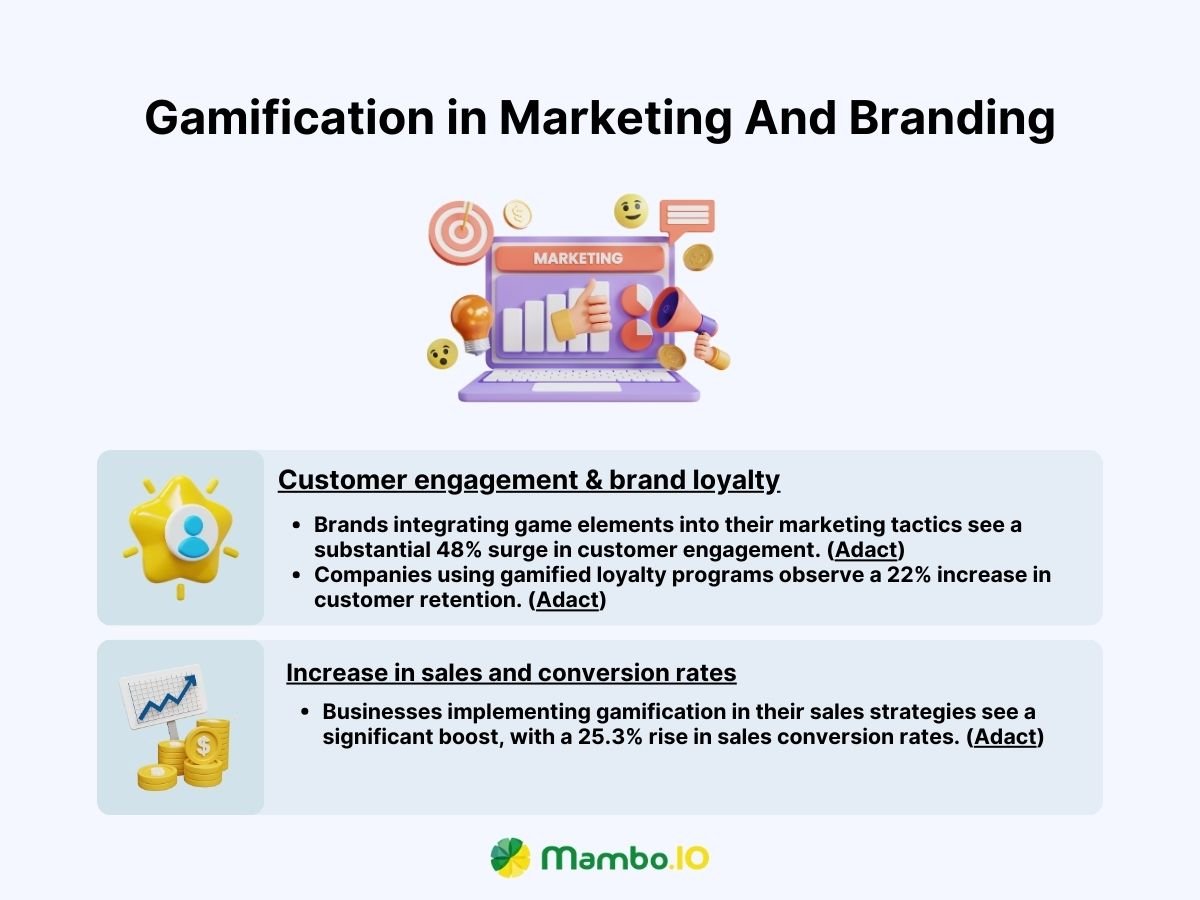
Customer engagement and brand loyalty
Gamification has proven itself to be an effective catalyst for enhancing customer engagement. By integrating game elements into marketing tactics, brands are experiencing a significant 48% increase in customer engagement. This strategy attracts and retains customers, which creates an engaging experience that fosters active engagement and a deeper connection.
Moreover, gamification has become a strategic asset in nurturing brand loyalty. Companies that leverage gamified loyalty programmes witnessed a 22% upswing in customer retention. These programmes offer rewards such as virtual badges and points, which do more than just encourage repeat purchases. Ultimately, they help foster a community feeling and a sense of exclusivity for customers.
Increase in sales and conversion rates
Gamification’s influence extends to sales, with a notable 25.3% conversion rate boost when integrated into the sales process. It leverages the competitive nature of consumers, spurring them to finalise purchases and engage more thoroughly. In turn, it increases the businesses’ sales and revenue.
Other interesting marketing and branding gamification statistics you need to know
- In 2022, the marketing sector was the top user of gamification technology, holding the biggest portion of the market. (PS Market Research)
- A vast majority of marketers, 93%, love gamification. (Demand Gen)
- 70% still see value in non-interactive content for engaging visitors. (Demand Gen)
- A larger number, 81%, find interactive content more captivating than its static counterpart. (Demand Gen)
- 88% of B2B marketers intend to transform 10 to 30% of their content into interactive formats. (Demand Gen)
- Approximately 70% have found that interactive content effectively drives visitor conversions. (Demand Gen)
Gamification in Sales
Gamification has become such a game-changer in today’s highly competitive sales environment. It introduces game elements into sales to energise and inspire sales teams and customers in new and creative ways.
Let’s look at the figures below and see how gamification significantly boosts a business’ sales.
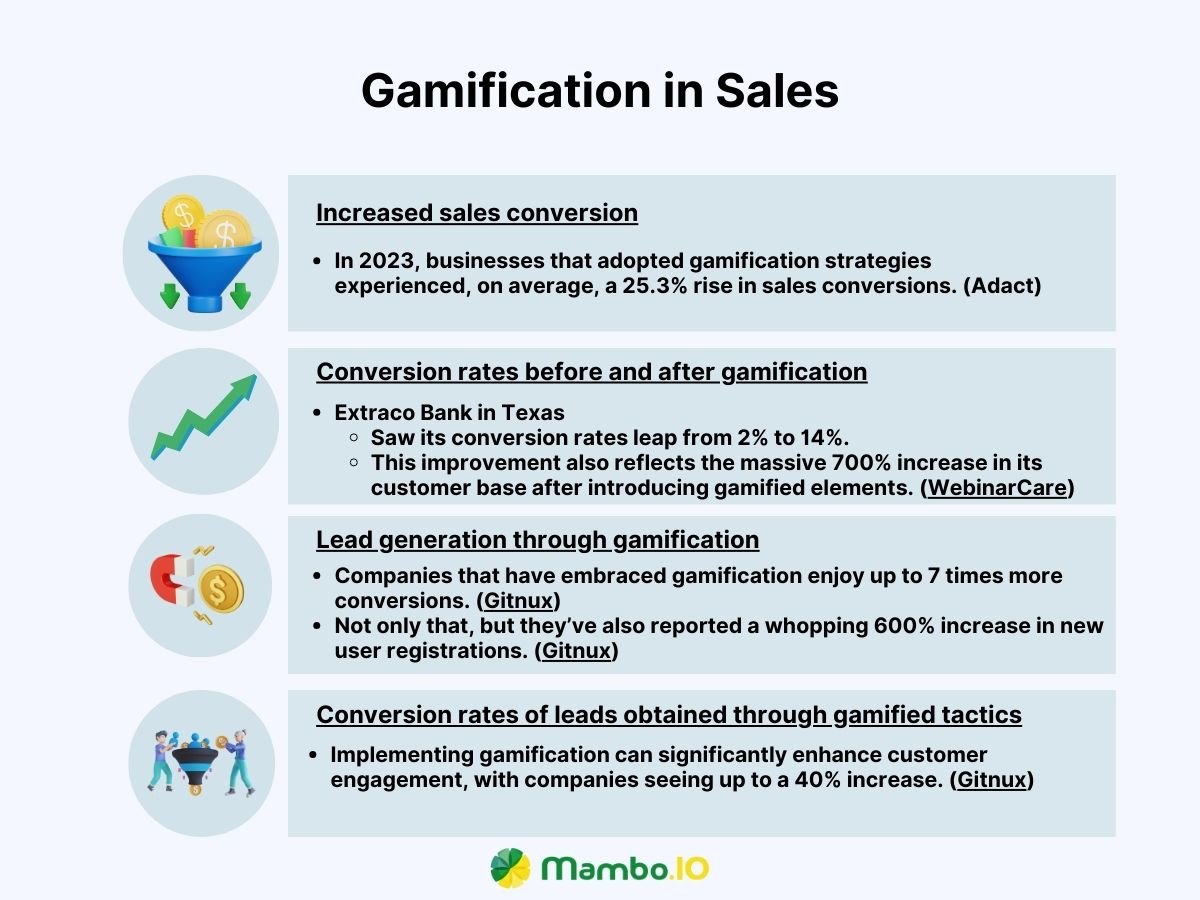
Increased sales conversion
Companies are leveraging gamification to enhance their sales conversions significantly. In 2023, businesses that adopted gamification strategies experienced, on average, a 25.3% rise in sales conversions. This increase is largely due to gamification’s ability to engage consumer’s competitive instincts. As a result, it encourages them to make purchases and achieve related goals.
Conversion rates before and after gamification
Gamification’s effect is starkly evident in its capacity to improve conversion rates post-implementation. One example is the Extraco Bank in Texas, which saw its conversion rates leap from 2% to 14%. This improvement also reflects the massive 700% increase in its customer base after introducing gamified elements.
Autodesk, a well-known software company, saw a 40% rise in trial usage due to gamification. With this approach, they also experienced a 15% boost in the number of people upgrading from the trial.
Moreover, gamified customer engagement approaches have led to a 54% rise in trial usage and 15% in purchase clicks. These massive improvements clearly show how effective gamification can boost sales and revenue.
Lead generation through gamification
Companies that have embraced gamification enjoy up to 7 times more conversions. Not only that, but they’ve also reported a whopping 600% increase in new user registrations. This significant jump proves how gamification can engage and win over potential customers. It creates an active, exciting space that meets the changing needs of both workers and buyers.
Conversion rates of leads obtained through gamified tactics
Implementing gamification can significantly enhance customer engagement, with companies seeing up to a 40% increase. This uptick in engagement not only improves lead quality but also boosts conversion rates. That’s because gamified features help customers understand products better and feel closer to the brand, leading to more conversions.
Other interesting sales gamification statistics you need to know
- By 2025, we can expect the global gamification market to surge, potentially hitting a massive $32 billion in sales revenue. (WebinarCare)
- In the U.S., 30% of people between 16 and 24 years old now see gamification in sales in a better light. (WebinarCare)
- Incorporating gamification into sales meetings and contact centres can cut down call duration by 15% and increase sales by approximately 10%. (Gamification Co)
- In some instances, sales gamification has boosted sales by a staggering 90%, showcasing its effectiveness in boosting customer engagement and motivation. (Zipdo)
- A whopping 90% of sales directors reported that gamification has positively impacted their sales figures. (Forbes)
- Companies that have leveraged gamification in their sales strategies witnessed a 25.3% rise in sales conversions. (Adact)
- Businesses that have integrated game-like elements into their processes have enjoyed an average revenue growth of 4.1% annually. (Spinify)
- Engaged customers are key to profitability, contributing to a 23% increase, while disengaged customers can result in a 13% dip in profits. (Spinify)
- Websites that offer interactive content boast conversion rates that are six times higher than their static counterparts. (Spinify)
Regional growth of gamification
The regional expansion of gamification is a testament to its broad appeal and versatility across various markets worldwide. As more areas embrace this approach, the global gamification landscape is rapidly changing, revealing unique trends and growth opportunities.
Rapid growth in Africa
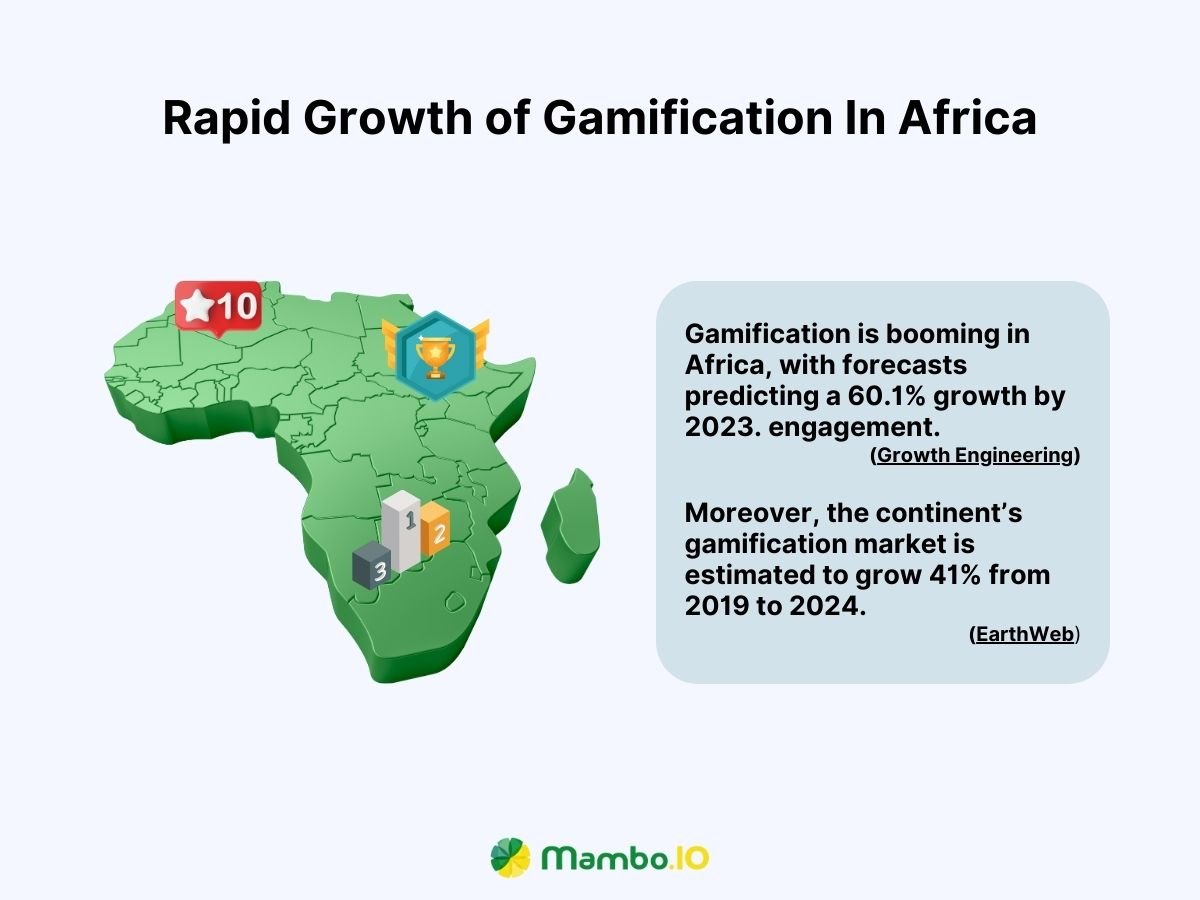
Gamification is booming in Africa, with forecasts predicting a 60.1% growth by 2023. Local and regional companies increasingly offer gamified solutions, capitalising on the continent’s growing number of tech enthusiasts. By integrating gamification into education and corporate strategies, they’re capturing user interest and revolutionising learning, efficiency, and customer engagement.
Moreover, the continent’s gamification market is estimated to grow 41% from 2019 to 2024. This signals a sustained interest and investment in this innovative field. This growth is part of Africa’s more significant technological adoption and innovation trend.
Emergence of gamification in Latin America and the Middle East
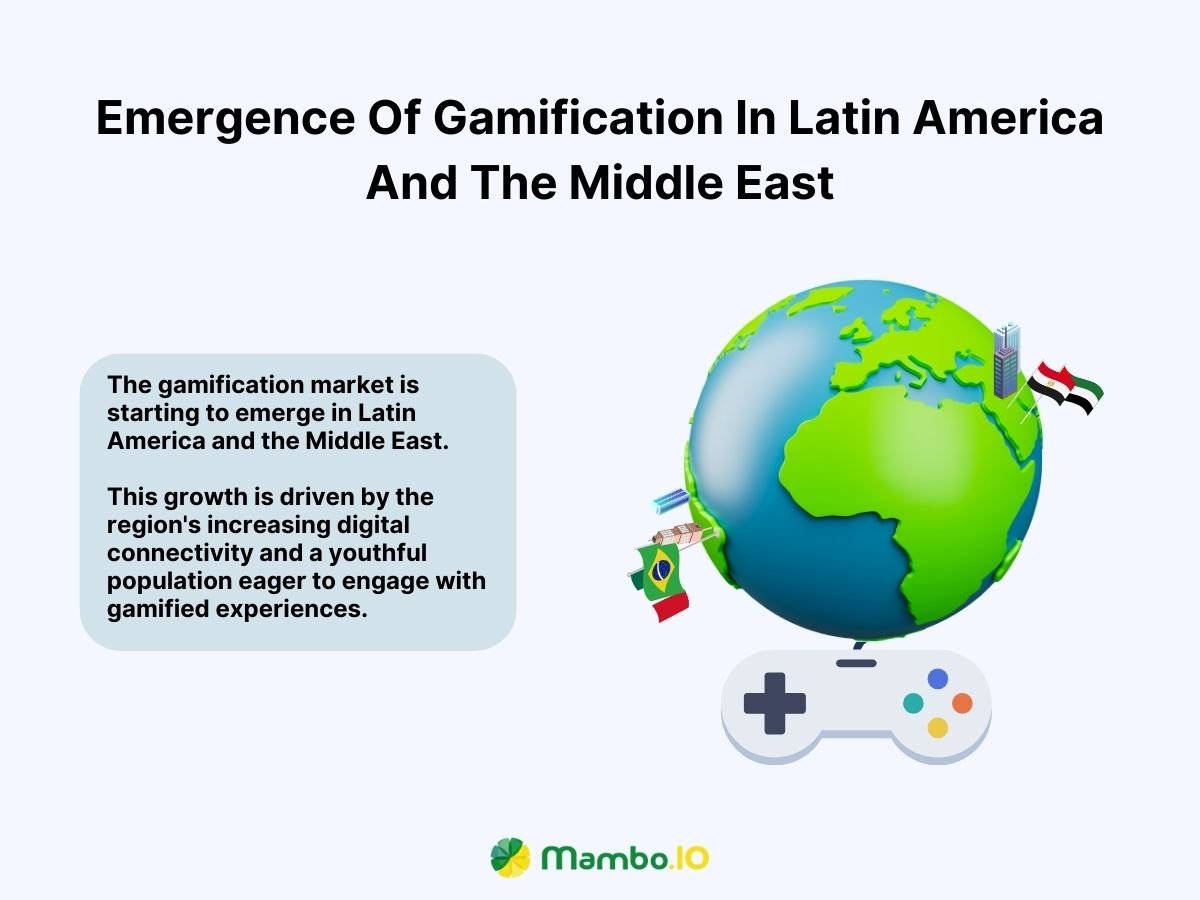
The gamification industry is also thriving in Latin America and the Middle East. The introduction of gamification in these regions is primarily driven by startups adapting to gamified solutions, particularly in the educational sector.
The rise of eLearning and game-based education in Brazil notably contributes to the region’s gamification momentum. The gamification market in Latin America is expected to grow by 30%. This growth is driven by the region’s increasing digital connectivity and a youthful population eager to engage with gamified experiences.
Similarly, the Middle East is seeing growth in the gamification market. This growth reflects the region’s budding interest in gamification to enhance user engagement and experience. These developments signal a promising horizon for gamification globally. It’s becoming an increasingly popular tool for achieving various learning and business goals.
Industry-wide adoption and market value
As we’ve seen, the concept of gamification has firmly entrenched itself across various industries. And in doing so, it has reshaped how we view and operate around engagement metrics and user experiences.
Applying game design elements in non-game contexts is no longer a niche experiment but a mainstream strategy. It continues to prove its value in enhancing productivity, customer loyalty, and educational outcomes worldwide.
Global market growth
The global gamification market is witnessing robust growth, with projections indicating an increase from $13.26 billion in 2022 to $58.71 billion by 2027. This translates to a CAGR of around 24.88% over the forecast period.
Further broadcasts suggested the market could swell to $96.3 billion by 2030, with a CAGR of 2023 to 2030. The momentum is consistent, with estimates indicating a reach of $103.30 billion by 2029.
North american market
North America has widely embraced gamification. Let’s look at the forecast period of 2022 to 2028. The projections from this period suggest that the North American gamification market will grow at a 26.2% CAGR. Once 2030 arrives, this value can reach up to $72.26 billion.
Many mobile internet users and a strong inclination towards engaging technologies underpin this growth. The North American industry is also valued at $2.72 billion, indicating the lucrative nature of the market in this region.
Corporate adoption
The corporate sector is one of the primary drivers of gamification’s exponential growth. Approximately 90% of employees report increased productivity when gamified elements are integrated into their work processes. The engagement levels see a substantial boost of 48%, signalling that gamification makes work enjoyable and enhances employee performance.
The corporate demand for gamification in employee engagement and training dramatically contributes to the market’s expected growth to $53.2 billion by 2028.
Gamification will continue to grow in the coming years, especially with the emerging trends to change the game. The market for this strategy is already booming, and many new key players will propel its development. We’re discussing AI, AR/VR, and many other technological innovations.
Let’s look at the emerging trends that will catalyse the growth of gamification in 2024.
Augmented reality (AR) and virtual reality (VR)

AR and VR are the top methods for providing unique and immersive experiences beyond conventional limits. These technologies are versatile, but they’ve proven quite beneficial when applied to gamification. Combined with gamification, these technologies can revolutionise corporate training, education, and health sectors.
A 2022 survey by PwC highlighted that VR trainees absorb knowledge four times faster than classroom learners. Moreover, they feel 275% more confident applying their learned skills. As we enter 2024, expect to see a rise in mixed-reality environments where AR and VR converge. These technologies are invaluable in creating experiences that combine the real and digital realms.
Artificial intelligence (AI)
AI brings dynamic changes in gamification that make experiences more personalised and engaging. Its impact is particularly evident in its ability to learn from user interactions and adapt to enhance the gaming experience.

Personalised gamified experiences
AI can tailor experiences to individual users. By analysing the user’s data, it adapts challenges and content to align with each user’s unique preferences and abilities. This personalised approach ensures they are continuously engaged by relevant and appropriately challenging content.
Predictive analytics in gamified scenarios
Predictive analytics in gamification leverages AI to adjust to user interactions dynamically. It can provide real-time feedback, guide learning pathways, and calibrate challenges based on performance data. Predictive analytics is making its mark across multiple fields, including education and healthcare. As we move into 2024, it’s set to remain a transformative factor in the world of gamification.
Social gamification
Gamification has steadily slithered its way into social platforms. In doing so, it has evolved into a cornerstone strategy for enhancing user experience and engagement.
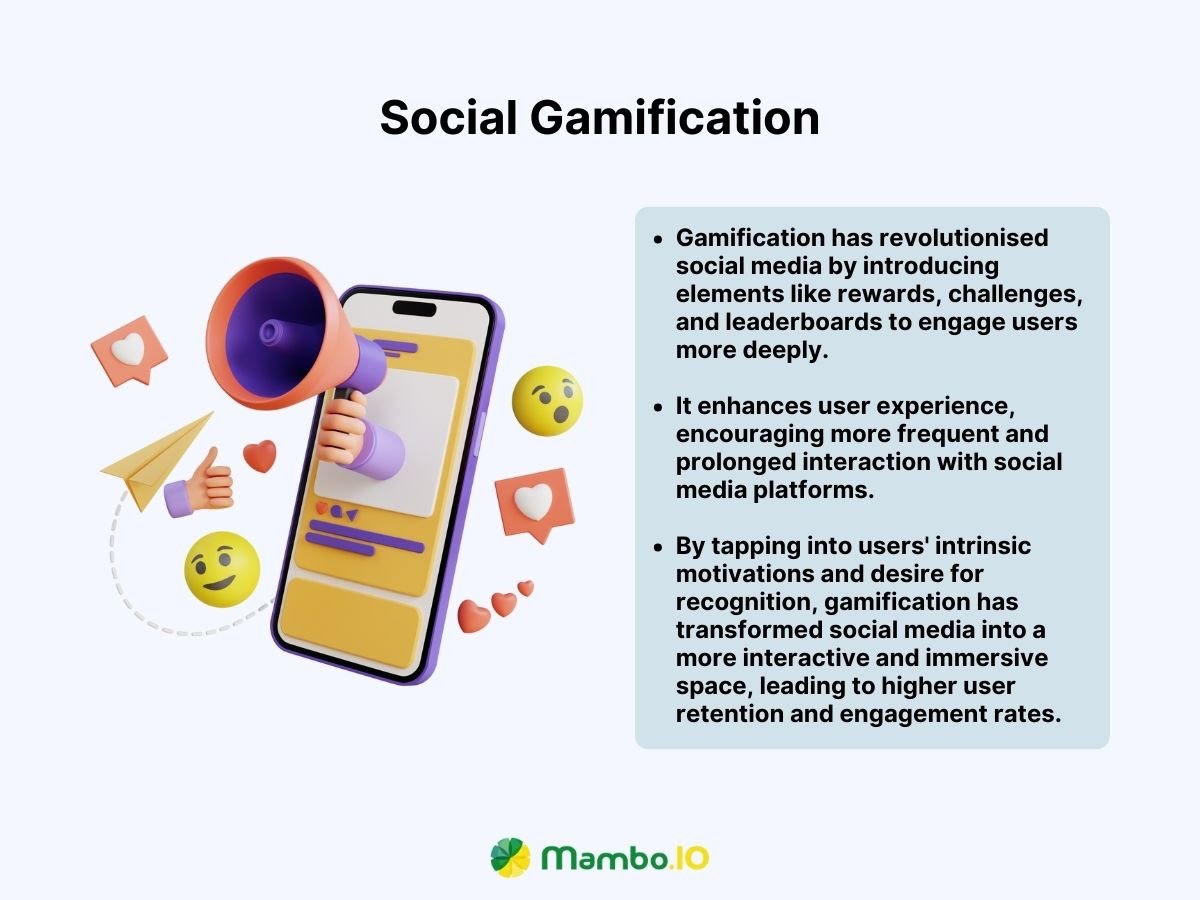
Social gamification leverages game design elements to motivate member participation, engagement, and loyalty. By tapping into the natural human propensity for competition, achievement, and collaboration, it transforms otherwise mundane interactions into rewarding experiences.
Microlearning and bite-sized challenges
Microlearning and bite-sized challenges cater to the modern learner’s preference for quick and impactful learning sessions. It’s an agile and focused way to learn in today’s fast-paced digital environment.

The numbers speak for themselves regarding the effectiveness of microlearning: Research shows that microlearning is 17% more effective than traditional learning methods.
Learners can retain information up to 60% better with microlearning than traditional formats. Additionally, completion rates for microlearning modules stand impressively between 70% and 80%. Studies highlight that information presented in smaller units is absorbed and retained 17% more efficiently. This approach also enhances retention and performance by up to 20%.
The format is particularly suited for corporate training, where it has been seen to improve retention rates by up to 60%. Additionally, it enhances completion rates by as high as 82%.
Gamification has been transforming how we interact with technology, brands, businesses, and others. Looking toward the future, integrating game mechanics into business operations remains a powerful strategy. This approach is increasingly shaping engagement across various industries.
We will look at some key trends to watch in the coming years.
Prediction for the next few years
Experts will witness significant growth in the gamification market in the coming years. This can be attributed to technological advancements and increasing demands for engaging and interactive user experiences.
Additionally, remote work and online learning persisted even after the pandemic ended. With this in mind, more people are anticipated to become more prevalent in virtual environments. These demographics will be one of those who will enjoy immersive and personalised gamified learning and working environments.
Potential industries to be influenced by gamification
Gamification has been making massive ripples in different sectors for the past few years. Considering this, let’s examine which industries will likely gain the most from gamification soon.
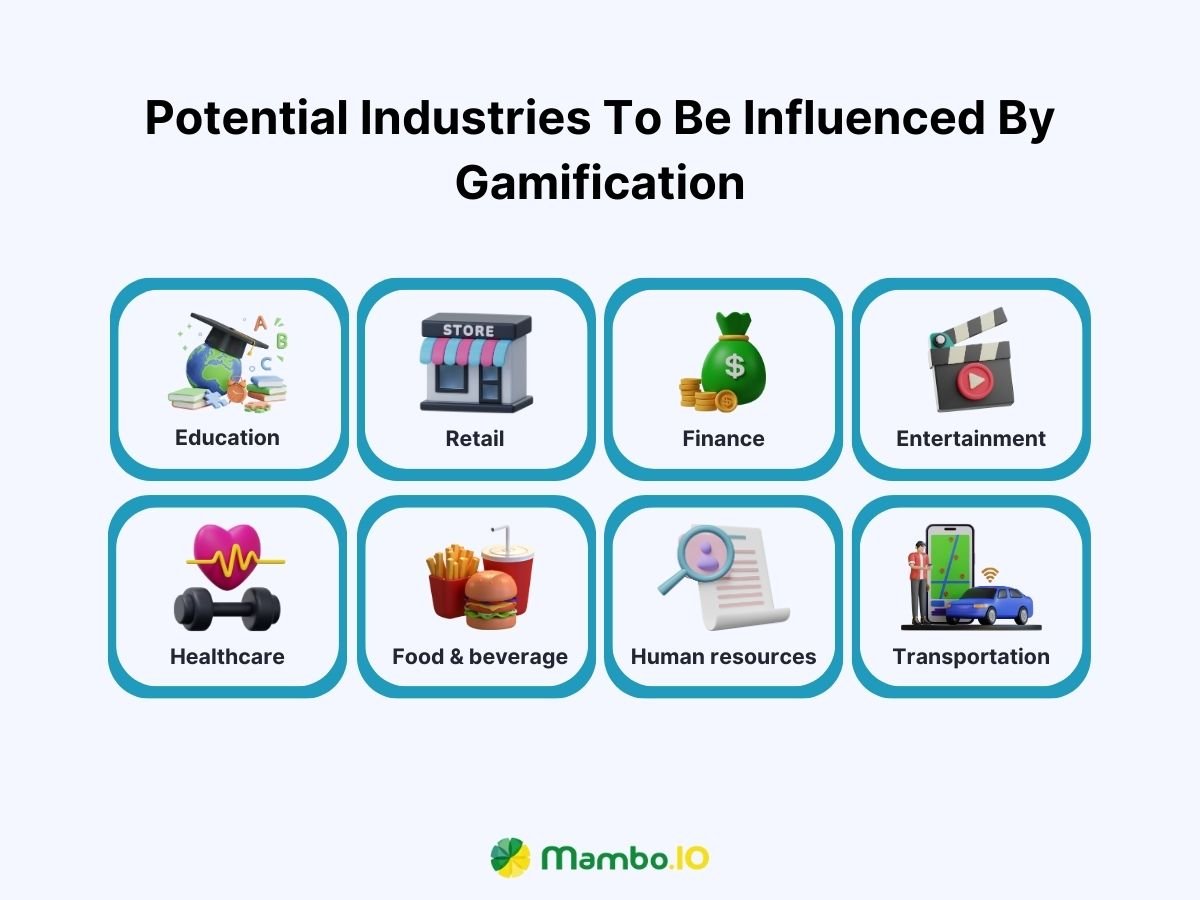
Education
The education sector is one of the earliest adopters of gamification. Judging from the existing learning environments, it’s clear that gamification will continue to be a practical learning approach.
That’s because gamification effectively meets the demands of today’s learners, thanks to game elements such as points, badges, and leaderboards. This strategy aligns well with the current trend that learners seek more dynamic and participative educational approaches.
Retail
As retail businesses shift toward eCommerce, gamification becomes critical for engaging customers. Gamification platforms can customise customer experience using AI and machine learning to enhance brand loyalty and engagement.
Finance
Gamification transforms the finance industry, particularly in financial education, making it more interactive with reward systems and challenges. This approach increases users’ financial literacy and helps convert them into leads for banks and fintech companies.
Entertainment
The entertainment industry uses gamification to engage audiences in activities ranging from concerts to virtual reality experiences. Gamification is here to provide enjoyment and deepen user involvement and loyalty.
Healthcare
Gamification in healthcare is innovating patient care by encouraging medication compliance and promoting healthy behaviours through gamified apps and wearables.
Food and beverage
This sector uses gamification to deliver nutrition education and marketing. Businesses that do so enhance their customer engagement and foster brand loyalty.
Human resources
Companies are turning to gamification to improve employee engagement and retention. More importantly, this approach helps them align their employees with company culture through interactive and rewarding experiences.
Transportation
The transportation industry leverages gamification to promote sustainable travel habits and boost traveller engagement. This is possible through interactive mobile apps and incentivisation strategies.
The adoption of gamification across these industries is a strategic move to provide better value to their users. By adopting gamification, organisations can utilise the power of motivation to empower their customers and employees for their benefit.